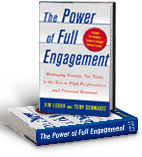Have you ever tried speaking to a tough crowd? How about teaching positive psychology to engineers?
Jocelyn Davis, of Nelson Hart LLC (@nelsonhartllc) has done just that at the University of Maryland for the last eight years. So she knows a tough audience. She shared the example on our webinar that often moves her students. Imagine that you had a high performance automobile and you ran it for weeks or months in the red zone. (At this point she says her students have their eyes wide open.) What would happen to the car? At some point it would no longer be a high performance car. You’d have to take it off the track. Students quickly grasp the analogy that you cannot burn yourself out at work – long hours with no breaks or no vacations, and still be ‘high performance’ in your job.
Originally I thought her webinar for Positive Business DC’s last week, “Happiness at Work: Measure it For Success” would mostly appeal to positive psychology practitioners who might need an assessment to use with clients. In the end, I discovered new things about the tool and practical ways to improve well-being at work – a place where people spend the majority of their lives.
Jocelyn started with a framework of well-being from Dr. Martin Seligman’s Authentic Happiness (which she candidly said she prefers to PERMA, his updated theory from the book Flourish*). This includes the following three things:
- Pleasure (a massage, a glass of wine),
- Meaning (using your strengths at work), and
- Engagement (your higher purpose, working at your kids school, etc).
(*Seligman’s new theory – PERMA – stands for Positive Emotion, Engagement, Relationships, Meaning and Achievement. You can find a great article about the new book here.)
Why Does Positive Psychology at Work Matter?
There are many reasons why it matters but here are three main reasons:
1) Better performance – Productivity, profitability, sales, creativity, customer service ratings, customer loyalty, retention of staff and customers. Well-being at work decreases healthcare costs. Measurements are important to business in traditional sense. You can create a happier workplace.
2) For people in the organization, the experience of their performance at work is enhanced. Well-being yields better organizational outcomes. It makes work positive and sustainable.
3) When people at work experience performance at work in better more positive way, there is a cascading effect into everyone they have contact with. If you are beaten down and working to burnout you go home to friends and family and pass that along. It is contagious. If we can increase happiness at work, we can help the experience of work and community by increasing happiness in that environment
Assessing Happiness at Work
If you’ve picked up a paper in the last few years you know that Bhutan has famously assessed its gross national happiness as opposed the American Gross Domestic Product (GDP). While the new leader of Bhutan has some new goals their reorientation to well-being was the impetus for the work. This inspired the British to create the national accounts of well-being. You can download the report here. While that report looks at the national level of well-being, the Happiness at Work survey looks at the workplace level of well-being.
The Survey
The survey is an empirically based 40 questions, which only takes 10-15 minutes to do. And it’s fairly easy to do in formatting screens they have created. You get your own results immediately. What is unusual in the survey arena, they also make your results available for a year. There was a person on our call who was surprised to receive a 2.6 (out of 10) on her Happiness at Work survey and was wondering what she could do about it. With this tool, she could decide on a plan of action and then take the survey few times. That way you can see if you are you making progress. Once you get your results, every question leads to research and specific actions, videos, articles, and books.
Results show that Brits assess their happiness as slightly lower than Americans (which could be our culturistic optimism). And Jocelyn shared that there are movements with Ben Bernanke and Daniel Kahneman to look at happiness measures for the U.S. Our group (Positive Business DC) was in the top 40% of happiness with some outliers.
The survey assesses four different areas: your personal resources, your experience of work, your functioning at work and your organizational system. Each of those areas breaks down into four categories that make it up. You can see how you scored on each one. I’ll cover two of the four areas here just to pique your interest to take the survey on your own.
Personal Resources
Since I found myself lowest in this category, I took an interest in the four areas that it comprises. Apparently this is true of younger working moms. When you move into upper management or are in the 50-65 year old age range your well-being at work increases.
- Vitality - Are you healthy and energetic? Do you get time to take a break every 90 minutes?
- Happiness - This equates to your personal happiness at work. It doesn’t mean that you are happy all the time. It is a net measurement.
- Confidence - Do you have resilience to bounce back from set backs?
- Work-life balance - What state are you in as you walk in the door at night?
If you are not sleeping, not eating well, and not socializing with friends, your score here might be low. Davis shared that frequently women are lower in this category because they don’t have the time to take care of themselves. And for her engineer students, since it is a male dominated profession, women might not find as many female friends at work. She recommended a great book called The Power of Full Engagement.
 Loehr and Schwartz talk about set up cycles of rest and recovery following periods of high stress. You can’t get up at 6, work from 7 to 7, skip lunch and breakfast and be at your best. You can find the book here. Having been through the training courses based on the book, I highly recommend it. It changed the way I thought about exercise on the road as well as what the real size of a ‘snack’ is. You can find out about the training course here.
Loehr and Schwartz talk about set up cycles of rest and recovery following periods of high stress. You can’t get up at 6, work from 7 to 7, skip lunch and breakfast and be at your best. You can find the book here. Having been through the training courses based on the book, I highly recommend it. It changed the way I thought about exercise on the road as well as what the real size of a ‘snack’ is. You can find out about the training course here.
High Functioning at Work
Performance at work is a result of four things that guide your intrinsic motivation:
- Strong work relationships – This is important for anyone who remembers the Gallup Q12. “Do you have a best friend at work?” is one of the best predictors of workplace well-being.
- Mastery – Can you make progress every day? Can you succeed at your work?
- Self expression – Can you be yourself? If you walked in tomorrow with three nose piercings would you be accepted?
- Sense ofcontrol – Do you get feedback? If not, can you ask for it?
For more on the factors that make up your Experience of Work and the Organizational System and we encourage you to take the survey and find out.
I was heartened to learn that entrepreneurs are the happiest group for which Davis has seen. They have more autonomous functioning and get to make decisions which put them in charge of their lives and work. They get immediate feedback and make progress every day. If you aren’t an entrepreneur, Davis recommended trying to create jobs that have self-employed elements to it.
You can find out more about Davis’ company at www.nelsonhartllc.com or @nelsonhartllc. Since she has an OD background as well as being the former CFO of AARP, she is definitely has a deep skill set to help your organization. You can find the recording of the webinar on our site www.positivebusinessdc.com and follow us on @positivebizdc. We wish you much happiness – at work and in life!
Some Related Links from this Webinar:
- -Webinar recording
- -National Accounts of Well-being Report
- Mentioned books:
- -The Power of Full Engagement by Loehr and Schwartz
- -The Thin book of Trust by Charles Feltman


